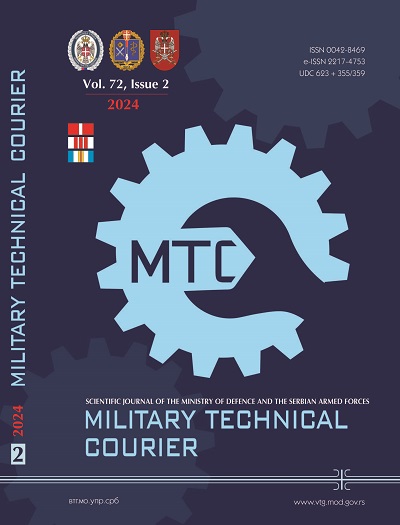Numerical investigation on the supersonic flow around a saboted bullet
Abstract
Introduction/purpose: In this paper, the aerodynamic characteristics of a special bullet were investigated at supersonic conditions. A model of a handgun saboted bullet was selected for the study.
Methods: The method used in the research was computational fluid dynamic (CFD) simulation. The turbulence model k-ε was used for numerical calculation. The air model was selected as an ideal gas. For air viscosity, the Sutherland model was applied.
Results: The numerical simulation results show the behavior of the supersonic flow over the saboted bullet. By varying the petals opening angle and bullet velocity, their influences on the drags of the sabot and the penetrator were obtained to be used for later sabot separation study.
Conclusion: The study shows that the CFD simulation approach can be implemented to analyze the aerodynamic drags on the sabot and the penetrator after the saboted bullet leaving the gun barrel. The simulation results obtained in this work are important in designing saboted light armor-piercing bullets fired from handguns.
References
Abdelsalam, O.R. & Fayed, A. 2022. Tungsten carbide core 12.7x99mm AP projectiles ballistic behavior against high hardness steel armor. Journal of Physics: Conference Series, 2299, art.number:012017. Available at: https://doi.org/10.1088/1742-6596/2299/1/012017.
-CBJ Tech. 2024. 6.5x25 CBJ APDS Tungsten core inside a discarding sabot. Cbjtech.com [online]. Available at: https://www.cbjtech.com/ammunition/6-5x25-cbj/6-5x25-cbj-apds/ [Accessed: 21 December 2023].
Do, V.M., Tran, T.H., Bui, X.S. & Le, D.A. 2022. Influence of spike-nosed length on aerodynamic drag of a wing-projectile model. Advances in Military Technology, 17(1), pp.33-45. Available at: https://doi.org/10.3849/aimt.01542.
Dolzhikov, V.I. & Nikolaev, A.V. 2015. Determination of aerodynamic characteristics of rotating aircraft in the uncontrolled flight by means of engineering analysis systems. Aerospace MAI Journal, 22(3), pp.47-53 [online]. Available at: https://vestnikmai.ru/eng/publications.php?ID=58907&eng=Y (in Russian) [Accessed: 20 January 2024].
Huang, Z.-g., Wessam, M.E. & Chen, Z.-h. 2014. Numerical investigation of the three-dimensional dynamic process of sabot discard. Journal of Mechanical Science and Technology, 28, pp.2637-2649. Available at: https://doi.org/10.1007/s12206-014-0620-6.
Ko, A., Chang, K., Sheen, D.-J., Lee, C.-H., Park, Y. & Park, S.W. 2020. Prediction and Analysis of the Aerodynamic Characteristics of a Spinning Projectile Based on Computational Fluid Dynamics. International Journal of Aerospace Engineering, 2020, art.ID:6043721. Available at: https://doi.org/10.1155/2020/6043721.
Launder, B.E. & Spalding, D.B. 1974. The numerical computation of turbulent flows. Computer Methods in Applied Mechanics and Engineering, 3(2), pp.269-289. Available at: https://doi.org/10.1016/0045-7825(74)90029-2.
Lesage, F. & Girard, B. 1996. Wind tunnel and CFD investigation of aerodynamic interactions during sabot separation. In: 34th Aerospace Sciences Meeting and Exhibit, Reno, NV, USA, January 15-18. Available at: https://doi.org/10.2514/6.1996-193.
Lin, H. & Lai, C.-L. 1997. Systematic study and numerical simulation of sabot projectile aerodynamics. Journal of the Chinese Institute of Engineers, 20(3), pp.275-284. Available at: https://doi.org/10.1080/02533839.1997.9741831.
Matsson, J.E. 2023. An Introduction to Ansys Fluent 2023. Mission, KS, USA: SDC Publications. ISBN: 978-1-63057-648-6.
-Ministry of Defence, Singapore. 2016. Engineering land systems. Singapore: Ministry of Defence [online]. Available at: https://www.mindef.gov.sg/oms/dam/publications/eBooks/DTC50/Engineering-Land-Systems.pdf [Accessed: 20 January 2024]. ISBN: 978-981-11-1490-8.
Odanović, Z. & Bobić, B. 2003. Ballistic protection efficiency of composite ceramics/metal armours. Scientific Technical Review, 53(3), pp.30-38 [online]. Available at: http://www.vti.mod.gov.rs/ntp/rad2003/3-03/odan/odan.pdf [Accessed: 20 January 2024].
Patanwala, H., Suresh, C. & Pawar, V. 2023. Computational Study of Safe Separation of Sabot from Penetrator in APFSDS. In: Edwin Geo, V. & Aloui, F. (Eds.) Energy and Exergy for Sustainable and Clean Environment, Volume 2, Green Energy and Technology, pp.279-294. Singapore: Springer. Available at: https://doi.org/10.1007/978-981-16-8274-2_19.
Starek, W. & Stepniak, W. 2021. Analysis and evaluation of small arms and ammunition with the reference to known foreign developments. Problemy Techniki Uzbrojenia/Issues of Armament Technology, R.35, z.99 pp.65-89. Available at: https://yadda.icm.edu.pl/baztech/element/bwmeta1.element.baztech-article-PWAA-0025-0007 (in Polish) [Accessed: 20 January 2024].
Stopforth, R. & Adali, S. 2019. Experimental study of bullet-proofing capabilities of Kevlar, of different weights and number of layers, with 9 mm projectiles. Defence Technology, 15(2), pp.186-192. Available at: https://doi.org/10.1016/j.dt.2018.08.006.
Trakic, A. 2020. Axial force coefficient of APFSDS projectile. Defense and Security Studies, 1(1), pp.1-15. Available at: https://doi.org/10.37868/dss.v1.id63.
Yaneva, S. 2020. Ballistic resistance of bulletproof vests level IIIA. Development of testing methodology. MATEC Web of Conferences, 317, art.number:06003. Available at: https://doi.org/10.1051/matecconf/202031706003.
Zochowski, P., Bajkowski, M., Grygoruk, R., Magier, M., Burian, W., Pyka, D., Bocian, M. & Jamroziak, K. 2021. Ballistic Impact Resistance of Bulletproof Vest Inserts Containing Printed Titanium Structures. Metals,11(2), art.number:225. Available at: https://doi.org/10.3390/met11020225.
Copyright (c) 2024 Quang Tuan Nguyen, Hai Minh Nguyen, Xuan Son Bui

This work is licensed under a Creative Commons Attribution 4.0 International License.
Proposed Creative Commons Copyright Notices
Proposed Policy for Military Technical Courier (Journals That Offer Open Access)
Authors who publish with this journal agree to the following terms:
Authors retain copyright and grant the journal right of first publication with the work simultaneously licensed under a Creative Commons Attribution License that allows others to share the work with an acknowledgement of the work's authorship and initial publication in this journal.
- Authors are able to enter into separate, additional contractual arrangements for the non-exclusive distribution of the journal's published version of the work (e.g., post it to an institutional repository or publish it in a book), with an acknowledgement of its initial publication in this journal.
- Authors are permitted and encouraged to post their work online (e.g., in institutional repositories or on their website) prior to and during the submission process, as it can lead to productive exchanges, as well as earlier and greater citation of published work (See The Effect of Open Access).

